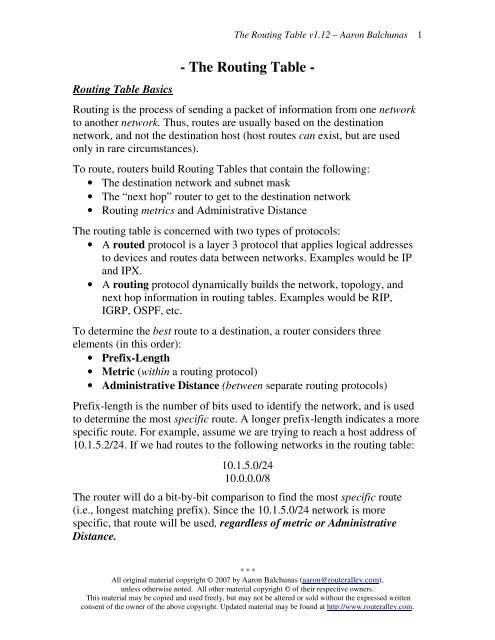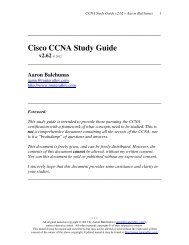The Routing Table - Router Alley
The Routing Table - Router Alley
The Routing Table - Router Alley
Create successful ePaper yourself
Turn your PDF publications into a flip-book with our unique Google optimized e-Paper software.
<strong>The</strong> <strong>Routing</strong> <strong>Table</strong> v1.12 – Aaron Balchunas<br />
1<br />
<strong>Routing</strong> <strong>Table</strong> Basics<br />
- <strong>The</strong> <strong>Routing</strong> <strong>Table</strong> -<br />
<strong>Routing</strong> is the process of sending a packet of information from one network<br />
to another network. Thus, routes are usually based on the destination<br />
network, and not the destination host (host routes can exist, but are used<br />
only in rare circumstances).<br />
To route, routers build <strong>Routing</strong> <strong>Table</strong>s that contain the following:<br />
• <strong>The</strong> destination network and subnet mask<br />
• <strong>The</strong> “next hop” router to get to the destination network<br />
• <strong>Routing</strong> metrics and Administrative Distance<br />
<strong>The</strong> routing table is concerned with two types of protocols:<br />
• A routed protocol is a layer 3 protocol that applies logical addresses<br />
to devices and routes data between networks. Examples would be IP<br />
and IPX.<br />
• A routing protocol dynamically builds the network, topology, and<br />
next hop information in routing tables. Examples would be RIP,<br />
IGRP, OSPF, etc.<br />
To determine the best route to a destination, a router considers three<br />
elements (in this order):<br />
• Prefix-Length<br />
• Metric (within a routing protocol)<br />
• Administrative Distance (between separate routing protocols)<br />
Prefix-length is the number of bits used to identify the network, and is used<br />
to determine the most specific route. A longer prefix-length indicates a more<br />
specific route. For example, assume we are trying to reach a host address of<br />
10.1.5.2/24. If we had routes to the following networks in the routing table:<br />
10.1.5.0/24<br />
10.0.0.0/8<br />
<strong>The</strong> router will do a bit-by-bit comparison to find the most specific route<br />
(i.e., longest matching prefix). Since the 10.1.5.0/24 network is more<br />
specific, that route will be used, regardless of metric or Administrative<br />
Distance.<br />
* * *<br />
All original material copyright © 2007 by Aaron Balchunas (aaron@routeralley.com),<br />
unless otherwise noted. All other material copyright © of their respective owners.<br />
This material may be copied and used freely, but may not be altered or sold without the expressed written<br />
consent of the owner of the above copyright. Updated material may be found at http://www.routeralley.com.
<strong>The</strong> <strong>Routing</strong> <strong>Table</strong> v1.12 – Aaron Balchunas<br />
2<br />
Administrative Distance vs. Metric<br />
A “metric” allows a router to choose the best path within a routing protocol.<br />
Distance vector routing protocols use “distance” (usually hop-count) as their<br />
metric. Link state protocols utilize some sort of “cost” as their metric.<br />
Only routes with the best metric are added to the routing table. Thus, even<br />
if a particular routing protocol (for example, RIP) has four routes to the<br />
same network, only the route with the best metric (hop-count in this<br />
example) would make it to the routing table. If multiple equal-metric routes<br />
exist to a particular network, most routing protocols will load-balance.<br />
If your router is running multiple routing protocols, Administrative<br />
Distance is used to determine which routing protocol to trust the most.<br />
Lowest administrative distance wins.<br />
Again: if a router receives two RIP routes to the same network, it will use<br />
the routes’ metric to determine which path to use. If the metric is identical<br />
for both routes, the router will load balance between both paths.<br />
If a router receives a RIP and an OSPF route to the same network, it will use<br />
Administrative Distance to determine which routing path to choose.<br />
<strong>The</strong> Administrative Distance of common routing protocols (remember,<br />
lowest wins):<br />
Connected 0<br />
Static 1<br />
EIGRP Summary 5<br />
External BGP 20<br />
Internal EIGRP 90<br />
IGRP 100<br />
OSPF 110<br />
IS-IS 115<br />
RIP 120<br />
External EIGRP 170<br />
Internal BGP 200<br />
Unknown 255<br />
A route with an “unknown” Administrative Distance will never be inserted<br />
into the routing table.<br />
* * *<br />
All original material copyright © 2007 by Aaron Balchunas (aaron@routeralley.com),<br />
unless otherwise noted. All other material copyright © of their respective owners.<br />
This material may be copied and used freely, but may not be altered or sold without the expressed written<br />
consent of the owner of the above copyright. Updated material may be found at http://www.routeralley.com.
<strong>The</strong> <strong>Routing</strong> <strong>Table</strong> v1.12 – Aaron Balchunas<br />
3<br />
Viewing the routing table<br />
<strong>The</strong> following command will allow you to view the routing table:<br />
<strong>Router</strong># show ip route<br />
Gateway of last resort is 192.168.1.1 to network 0.0.0.0<br />
C 192.168.1.0/24 is directly connected, Ethernet0<br />
150.50.0.0/24 is subnetted, 1 subnets<br />
C 150.50.200.0 is directly connected, Loopback1<br />
C 192.168.123.0 is directly connected, Serial0<br />
C 192.168.111.0 is directly connected, Serial1<br />
R 10.0.0.0 [120/1] via 192.168.123.1, 00:00:00, Serial0<br />
[120/1] via 192.168.111.2, 00:00:00, Serial1<br />
S* 0.0.0.0/0 [1/0] via 192.168.1.1<br />
Routes are labeled based on what protocol placed them in the table:<br />
o C – Directly connected<br />
o S – Static<br />
o S* - Default route<br />
o D - EIGRP<br />
o R – RIP<br />
o I – IGRP<br />
o i – IS-IS<br />
o O - OSPF<br />
Notice the RIP routes contain the following field: [120/1]. This indicates<br />
both the administrative distance and the metric (the 120 is the AD, and the 1<br />
is the hop-count metric).<br />
To clear all routes from the routing table, and thus forcing any routing<br />
protocol to repopulate the table:<br />
<strong>Router</strong># clear ip route *<br />
* * *<br />
All original material copyright © 2007 by Aaron Balchunas (aaron@routeralley.com),<br />
unless otherwise noted. All other material copyright © of their respective owners.<br />
This material may be copied and used freely, but may not be altered or sold without the expressed written<br />
consent of the owner of the above copyright. Updated material may be found at http://www.routeralley.com.
<strong>The</strong> <strong>Routing</strong> <strong>Table</strong> v1.12 – Aaron Balchunas<br />
4<br />
Choosing the Best Route (Example)<br />
Assume the following routes existed to the following host: 192.168.111.5/24<br />
O 192.168.111.0/24 [110/58] via 192.168.131.1, 00:00:00, Serial3<br />
R 192.168.111.0/24 [120/1] via 192.168.123.1, 00:00:00, Serial0<br />
R 192.168.111.0/24 [120/5] via 192.168.5.2, 00:00:00, Serial1<br />
S 192.168.0.0/16 [1/0] via 10.1.1.1<br />
We have two RIP routes, an OSPF route, and a Static route to that<br />
destination. Which route will be chosen by the router?<br />
Remember the three criteria the router considers:<br />
• Prefix-Length<br />
• Metric<br />
• Administrative Distance<br />
<strong>The</strong> static route has the lowest administrative distance (1) of any of the<br />
routes; however, its prefix-length is less specific. 192.168.111.0/24 is a<br />
more specific route than 192.168.0.0/16. Remember, prefix-length is always<br />
considered first.<br />
<strong>The</strong> second RIP route will not be inserted into the routing table, because it<br />
has a higher metric (5) than the first RIP route (1). Thus, our routing table<br />
will actually look as follows:<br />
O 192.168.111.0/24 [110/58] via 192.168.131.1, 00:00:00, Serial3<br />
R 192.168.111.0/24 [120/1] via 192.168.123.1, 00:00:00, Serial0<br />
S 192.168.0.0/16 [1/0] via 10.1.1.1<br />
Thus, the true choice is between the OSPF route and the first RIP route.<br />
OSPF has the lowest administrative distance, and thus that route will be<br />
preferred.<br />
PLEASE NOTE: Calculating the lowest metric route within a routing<br />
protocol occurs before administrative distance chooses the route it “trusts”<br />
the most. This is why the order of the above “criteria” is prefix-length,<br />
metric, and then administrative distance.<br />
However, the route with the lowest administrative distance is always<br />
preferred, regardless of metric (assuming the prefix-length is equal). Thus,<br />
the metric is calculated first, but not preferred first over AD.<br />
* * *<br />
All original material copyright © 2007 by Aaron Balchunas (aaron@routeralley.com),<br />
unless otherwise noted. All other material copyright © of their respective owners.<br />
This material may be copied and used freely, but may not be altered or sold without the expressed written<br />
consent of the owner of the above copyright. Updated material may be found at http://www.routeralley.com.

















